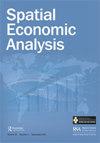The geographical and sectoral concentration of global supply chains
IF 2.2
3区 经济学
Q2 ECONOMICS
引用次数: 3
Abstract
ABSTRACT Due to international fragmentation, production increasingly occurs in global supply chains (GSC). The common belief is that this leads to more specialization, which implies more concentration of imports and exports over time. In this paper, we empirically test this hypothesis by analysing the geographical and sectoral concentration of GSC over the period 1995–2011. We adapt the traditional Herfindahl’s concentration indexes to a multi-regional input–output framework. Taking the information on intersectoral and interregional linkages into full account gives the concentration indexes of GSC. The indexes are at different aggregation levels, which enables us to examine both geographical and sectoral concentration patterns. After that, we analyse the effect a country’s geographical and sectoral concentration on its gross domestic product (GDP) per capita. Our findings are: an increase of geographical and sectoral concentration of GSC from 1995 to 2011; a growing role in global production chains played by China and other Asian countries; less concentration for European Union countries; a significant positive effect of geographical concentration on GDP per capita; and a significant negative effect of sectoral concentration.全球供应链的地域和部门集中
摘要由于国际分工,全球供应链中的生产越来越多。人们普遍认为,这会导致更多的专业化,这意味着随着时间的推移,进出口更加集中。在本文中,我们通过分析1995-2011年期间GSC的地理和部门集中度来实证检验这一假设。我们将传统的赫芬达尔集中度指数调整为多区域投入产出框架。充分考虑跨部门和区域间联系的信息,可以得出GSC的集中度指数。这些指数处于不同的聚合水平,这使我们能够研究地理和部门集中模式。然后,我们分析了一个国家的地理和部门集中度对其人均国内生产总值的影响。我们的研究结果是:从1995年到2011年,GSC的地理和部门集中度增加;中国和其他亚洲国家在全球生产链中发挥的作用越来越大;欧洲联盟国家的集中度较低;地域集中对人均国内生产总值的显著积极影响;以及部门集中的显著负面影响。
本文章由计算机程序翻译,如有差异,请以英文原文为准。
求助全文
约1分钟内获得全文
求助全文
来源期刊

Spatial Economic Analysis
ECONOMICS-
CiteScore
5.40
自引率
21.70%
发文量
33
期刊介绍:
Spatial Economic Analysis is a pioneering economics journal dedicated to the development of theory and methods in spatial economics, published by two of the world"s leading learned societies in the analysis of spatial economics, the Regional Studies Association and the British and Irish Section of the Regional Science Association International. A spatial perspective has become increasingly relevant to our understanding of economic phenomena, both on the global scale and at the scale of cities and regions. The growth in international trade, the opening up of emerging markets, the restructuring of the world economy along regional lines, and overall strategic and political significance of globalization, have re-emphasised the importance of geographical analysis.
 求助内容:
求助内容: 应助结果提醒方式:
应助结果提醒方式:


